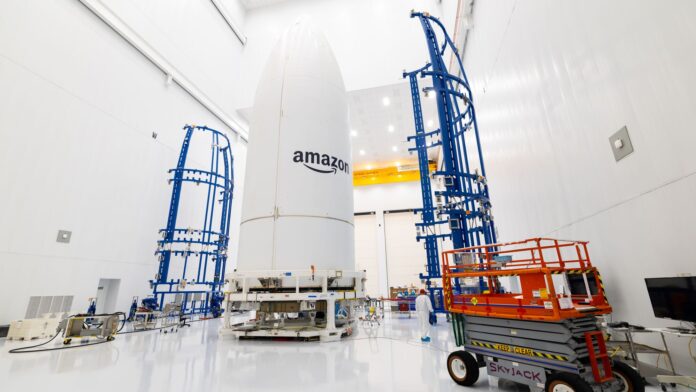Kuiper LEO satellites will join the broadband space race
Amazon’s Project Kuiper expects to launch more than two dozen LEO satellites by mid-April and start offering service later this year, setting up a duel with dominant LEO broadband provider Starlink.
Amazon said that its first-generation Kuiper system will include more than 3,200 satellites and that it already has arrangements made for more than 80 launches to support that constellation.
The KA-01 launch, with a current launch window of April 9, between 12 and 3 p.m. EDT, is “just the first step in that process,” the company said. (Launch updates and a live broadcast are available here.)
Amazon plans to deliver “high-speed, low-latency internet to virtually any location on the planet,” with service starting later this year that is expected, like Starlink, to use a proprietary broadband approach. Kuiper has existing relationships with telecom operators including Vodafone and Verizon—both of which are also investors in nascent LEO broadband provider AST SpaceMobile, which launched the first five satellites of its constellation last fall.
“We’ve designed some of the most advanced communications satellites ever built, and every launch is an opportunity to add more capacity and coverage to our network,” said Rajeev Badyal, VP of Project Kuiper. “We’ve done extensive testing on the ground to prepare for this first mission, but there are some things you can only learn in flight, and this will be the first time we’ve flown our final satellite design and the first time we’ve deployed so many satellites at once.”
Amazon outlined in a blog post the testing and upgrades that it has done to the soon-to-be-launched satellites after a prototype mission in late 2023. The company said in a blog post that it has “improved the performance of every system and sub-system on board, including phased array antennas, processors, solar arrays, propulsion systems, and optical inter-satellite links.”
Badyal added: “No matter how the mission unfolds, this is just the start of our journey, and we have all the pieces in place to learn and adapt as we prepare to launch again and again over the coming years.”
After the launch and commissioning of the satellites, Amazon said that it “will continue to increase our production, processing, and deployment rates as we prepare to begin delivering service to customers. We have already begun shipping and processing satellites for our next mission,” the company added. Amazon has said that it expects to invest $10 billion in Kuiper.
Starlink, meanwhile, is extending its reach beyond direct to consumer, government and business broadband with partnerships—including a cellular direct-to-device partnership with T-Mobile US which is in beta testing, and ramping up its position in providing connectivity for airplanes—which is one of the use cases being eyed for 5G Non-Terrestrial Networks (NTN). (Read more about the latest on T-Mobile US’ NTN beta in this story.)
This week, United Airlines received approval from the Federal Aviation Administration to start testing Starlink-based airplane connectivity across the airline’s regional jet fleet.

The first flight with commercially available internet service from Starlink is expected to happen next month on an Embraer 175. United says that Starlink’s equipment is smaller, lighter and easier to install, and that it will provide Wi-Fi speeds up to 250 Mbps—50 times currently available speeds on regional flights, according to the airline.
United has said that it plans to make Starlink access free to all customers who are members of its MileagePlus program.
For more insights on the potential of 5G NTN technology, check out RCR Wireless News’ editorial report on standardization and commercialization of non-terrestrial networks here.

